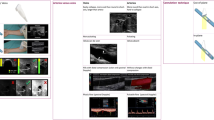Abstract
Background
Central venous catheterization may be difficult in morbidly obese patients because anatomic landmarks are often obscured.
Methods
We evaluated the efficacy and safety of ultrasound-guided central venous cannulation in 55 patients undergoing bariatric surgery. The usefulness of ultrasonic examination combined with intraatrial electrocardiogram as a diagnostic tool for catheter misplacement was studied.
Results
Preliminary ultrasound examination of the neck vessels demonstrated anatomical variations in the position of internal jugular vein in 19 cases and four unrecognized asymptomatic thromboses of the right internal jugular vein. Central venous catheterization was successful in all 55 patients, in 51 with single skin puncture, and in 42 with single vein puncture. In three cases in whom the catheter was misplaced, this was detected by bedside ultrasonic examination during the procedure and immediately corrected by real-time echographic visualization. No arterial puncture, no hematoma, and no pneumothorax occurred in any patient. Successful catheter placement was also confirmed in all patients by post-operative chest X-ray. No evidence of infection or thrombosis subsequently was noted.
Conclusions
The use of ultrasound guidance may increase the success rate and decrease the incidence of complications associated with central venous cannulation. The advantages of this approach is visualization of the anatomical structures at puncture site prior to skin puncture and the ability to track needle and guide-wire placement during the procedure. With its high accuracy in detecting catheter misplacement, bedside ultrasonic examination combined with intraatrial electrocardiogram may further decrease morbidity associated with misplaced central venous catheters.




Similar content being viewed by others
References
National Institute for Clinical Excellence. NICE technology appraisal guidance No 49: guidance on the use of ultrasound locating devices for placing central venous catheters. London: NICE; 2002.
Karakitsos D, Labropoulos N, De Groot E, et al. Real-time ultrasound-guided catheterisation of the internal jugular vein: a prospective comparison with the landmark technique in critical care patients. Critical Care. 2006;10:R162.
Denys BG, Uretsky BF, Reddy PS. Ultrasound-assisted cannulation of the internal jugular vein. A prospective comparison to the external landmark-guided technique. Circulation. 1993;87(5):1557–62.
Urdaneta F, Gravenstein N. Central venous catheter insertion: it is finally time to start looking. Anesth Analg. 2007;105(3):879.
Graham AS, Ozment C, Tegtmeyer K, et al. Central venous catheterization. N Engl J Med. 2007;356:e21.
McGee DC, Gould MK. Preventing complications of central venous catheterization. N Engl J Med. 2003;348:1123–33.
Maury E, Guglielmotti J, Alzieu M, et al. Ultrasonic examination. An alternative to chest radiography after central venous catheter insertion? Am J Respir Crit Care Med. 2001;164:403–5.
Gebhard RE, Szmuck P, Pivalizza EG, et al. The accuracy of electrocardiogram-controlled central line placement. Anesth Analg. 2007;104(1):65–70.
Saager L, Wiesner E, Rothhammer A, Pestel G. Atrial electrocardiogram for verification of correct central venous catheter placement. Anesth Analg. 2007;105(5):1511.
Bodenham AR. Can you justify not using ultrasound guidance for central venous access? Critical Care. 2006;10:175.
Schummer W, Schummer C, Rose N, et al. Mechanical complications and malpositions of central venous cannulations by experienced operators. Intensive Care Med. 2007;33(6):1055–9.
Milling T, Golden C, Melniker L, et al. Randomized controlled trial of single-operator vs. two-operator ultrasound guidance for internal jugular central venous cannulation. Acad Emerg Med. 2006;13:245–7.
Lichtenstein DA, Mezière G, Lascols N, et al. Ultrasound diagnosis of occult pneumothorax. Crit Care Med. 2005;33:1231–8.
Jefferson P, Ball DR. Central venous access in morbidly obese patients. Anesth Analg. 2002;95(3):782.
Ottestad E, Schmiessing C, Brock-Utne JG, et al. Central venous access in obese patients: a potential complication. Anest Analg. 2006;102(4):1293–4.
Haaverstad R, Latto PN, Vitale N. Right subclavian catheter perforation of the aorta due to an incorrect external landmark-guided insertion technique. CJEM. 2007;9(1):43–5.
Fujiki M, Guta CG, Lemmens HJM, et al. Is it more difficult to cannulate the right internal jugular vein in morbidly obese patients than in non obese patients? Obes Surg. 2008;18:1157–9.
Turba U, Uflacker R, Hannegan C, et al. Anatomic relationship of the internal jugular vein and the common carotid artery applied to percutaneous transjugular procedures. Cardiovasc Intervent Radiol. 2005;28:303–6.
Troianos C, Kuwik R, Pasqual J, et al. Internal jugular vein and carotid artery anatomic relation as determined by ultrasonography. Anestesiology. 1996;85:43–8.
Maecken T, Grau T. Ultrasound imaging in vascular access. Crit Care Med. 2007;35(5):s178–85.
Puel V, Caudry M, Le Metayer P, et al. Superior vena cava thrombosis related to catheter malposition in cancer chemotherapy given through omplanted ports. Cancer. 1993;72:2248–52.
Luciani A, Clement O, Halimi P, et al. Catheter-related upper extremity deep venous thrombosis in cancer patients: a prospective study based on Doppler US. Radiology. 2001;220:655–60.
Chapman GA, Johnson D, Bodenham AR. Visualization of needle position using ultrasonography. Anesthesia. 2006;61:148–58.
Lichtenstein D, Meziere G, Lascols N, et al. Ultrasound diagnosis of occult pneumothorax. Crit Care Med. 2005;33(6):1231–8.
Farooq M. Can electrocardiogram-controlled central line placement decrease the need for routine chest radiographs after central venous cannulation? Anesth Analg. 2007;104(6):1614.
Lanza C, Russo M, Fabrizzi G. Central venous cannulation: are routine chest radiographs necessary after B.mode and color Doppler sonography check? Pediatr Radiol. 2006;36:1252–6.
Author information
Authors and Affiliations
Corresponding author
Additional information
Financial support
None.
Conflict of interest
None.
Rights and permissions
About this article
Cite this article
Brusasco, C., Corradi, F., Zattoni, P.L. et al. Ultrasound-Guided Central Venous Cannulation in Bariatric Patients. OBES SURG 19, 1365–1370 (2009). https://doi.org/10.1007/s11695-009-9902-y
Received:
Accepted:
Published:
Issue Date:
DOI: https://doi.org/10.1007/s11695-009-9902-y




